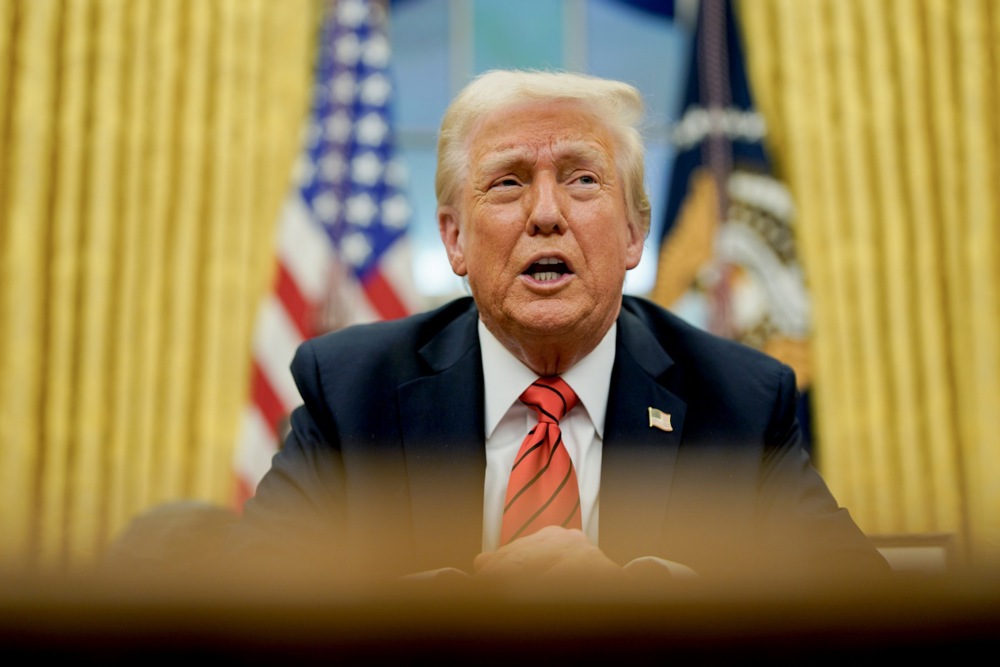The Great Tariff Resurgence - Inside Trump's Trade War And Its Far-Reaching Consequences
President Trump's tariff policies spark a transformative shift in global trade, igniting debates on protectionism, economic nationalism, and supply chain resilience.
Author:Darren McphersonReviewer:Camilo WoodFeb 15, 20257.4K Shares170K Views

In recent months, a series of executive orders from the Trump administration has sent shockwaves through the international economic landscape. The sudden imposition of these wide-ranging tariffs represents not just a policy change but a fundamental restructuring of America's relationship with its trading partners, raising profound questions about the future of globalization and America's place in the world economy.
The Anatomy Of Trump's Tariff Strategy
President Trump's approach to tariffs has been swift, comprehensive, and dramatically more extensive than during his first administration. Beginning with a series of executive orders, the administration has implemented or announced tariffs spanning multiple countries and sectors, creating a complex web of new trade barriers that affect virtually every aspect of the American economy.
The current tariff regime began taking shape immediately after Trump's inauguration when he signed an executive order instructing cabinet members to develop reports on trade practices and recommendations for tariffs. This initial action signaled the administration's intent to place trade policy at the center of its economic agenda.
The rapid pace continued throughout the period as Trump announced plans to increase tariffs on several key countries using various legal authorities. The tariffs were accompanied by product-specific measures targeting key industries.
These country-specific tariffs were accompanied by product-specific measures targeting key industries. The administration also took aim at the de minimis exemption, which had previously allowed low-value shipments to enter the country with minimal scrutiny and tariff-free, particularly affecting e-commerce from certain countries.
Perhaps most significant for the long-term trade landscape was Trump's directive to develop a plan for implementing reciprocal tariffs for every country, accounting for their existing tariffs, tax policies, and other factors such as exchange rates and alleged unfair practices. This comprehensive review signals the administration's intent to reshape America's entire approach to trade policy rather than merely addressing specific grievances with particular trading partners.
The Scale Of Economic Impact
The economic implications of these tariffs are substantial. According to economic analysis, the combined effect of all proposed Trump tariffs would reduce economic output and after-tax incomes across the economy. The revenue effects of these tariffs are projected to be enormous, though they essentially function as a tax on consumers and businesses, leading to higher prices and reduced purchasing power.
The distributional effects of the tariffs show that households across all income levels would experience reductions in after-tax income, with middle-income households bearing a significant burden. This creates significant uncertainty for American producers and consumers alike.
International Response And Escalating Trade Tensions
The global reaction to Trump's tariff offensive has been swift and substantial. Countries targeted by the new tariffs have responded with retaliatory measures of their own, raising the specter of a widening trade war that could further disrupt global commerce and economic growth.
The tariffs are creating particular tensions with close allies and neighbors. The planned tariffs on European Union imports represent another significant escalation in trade tensions with traditional allies. The authority for imposing these tariffs has not yet been specified, leaving uncertainty about their legal basis and potential challenges.
Economists argue that a full implementation of Trump's reciprocal tariff policy would raise the U.S. weighted average tariff rate, potentially triggering additional rounds of retaliation from trading partners worldwide.
Industry-Specific Impacts And Adaptations
The broad-based nature of Trump's tariffs means virtually no sector of the economy remains untouched, though some industries face particularly acute challenges or opportunities as the trade landscape transforms.
Automotive Sector
The automotive industry stands to be one of the most significantly affected sectors. The proposed tariffs on motor vehicles and motor vehicle parts would apply to imports valued at significant amounts. This would add to vehicle prices and potentially affect the profitability of automakers, particularly those with significant international supply chains.
The interconnected nature of North American auto manufacturing makes the industry particularly vulnerable to tariffs on Canadian and Mexican imports. Automakers face difficult choices about whether to absorb tariff costs, pass them on to consumers, or undertake the expensive process of reshoring production.
Pharmaceutical And Medical Device Industries
The healthcare product sector faces its own set of challenges from the tariff regime. The impact of tariffs could lead to increased costs for medicines, creating burdens for U.S. patients and the healthcare system. In the medical device industry, tariffs could lead to price increases and supply disruptions, affecting accessibility to medical devices.
Agricultural Sector
American farmers could face even greater challenges as the trade tensions escalate. Agricultural products are particularly vulnerable to retaliatory tariffs because they account for a large portion of U.S. exports, making them an obvious target for countries looking to respond to American trade measures.
Consumer Impact And Price Effects
The ultimate burden of tariffs often falls on consumers through higher prices for goods, reduced product availability, and potential quality trade-offs as companies seek less expensive alternatives to tariffed inputs.
The tariffs would function effectively as a regressive tax, with lower and middle-income households experiencing a proportionally greater reduction in after-tax income compared to the highest-income households. Consumers who frequently purchase imported goods or products with imported components would likely experience more substantial price increases than those whose consumption is concentrated in domestically produced goods and services.
Strategic Business Responses And Adaptation Pathways
Faced with this rapidly evolving trade environment, businesses across sectors are developing multifaceted strategies to mitigate risks and position themselves for the new economic reality.
Supply Chain Restructuring
One of the most significant business responses has been the acceleration of supply chain restructuring. Companies are diversifying suppliers across multiple countries, reshoring production to the United States, nearshoring to countries not currently targeted by tariffs, and strategically building inventory to create buffers against supply disruptions and price increases.
Technology And Advanced Manufacturing
Some businesses are accelerating their adoption of advanced manufacturing technologies to increase domestic production efficiency and offset the higher costs of reshoring. Digital technologies, automation, and artificial intelligence are being deployed to maximize productivity and minimize the cost differential between offshore and domestic manufacturing.
These technological adaptations require significant upfront investment but may yield long-term competitive advantages. Companies with the financial resources to make these investments could emerge from the tariff period with more resilient and efficient operations.
Pricing Strategies And Margin Management
Businesses face complex decisions about how to allocate the burden of tariff costs among themselves, their suppliers, and their customers. Some are engaging in aggressive negotiations with suppliers to share the cost impact. Others are carefully analyzing their product portfolios to determine where price increases can be implemented without significantly reducing demand.
The Long-Term Economic Calculus
Beyond the immediate disruptions and adaptations, economists and policy analysts are engaged in a deeper debate about the long-term implications of the Trump tariff strategy for the U.S. economy, global trade patterns, and international economic integration.
Historical Context And Precedent
The current tariff levels represent a significant departure from recent decades of U.S. trade policy, which has generally favored lower barriers and increased economic integration. This historical comparison raises important questions about whether the current tariff strategy represents a temporary negotiating tactic or a more fundamental shift in U.S. economic orientation.
Economic Theory And Empirical Evidence
The economic debate around tariffs has intensified as the policy moves from theoretical to actual implementation. Traditional economic theory suggests that tariffs generally reduce economic efficiency by interfering with comparative advantage, raising prices for consumers and input costs for businesses, and inviting retaliatory measures that harm exporters. However, proponents argue that tariffs can protect strategic industries, create leverage for negotiating better trade terms, and address unfair practices by trading partners.
Strategic Goals And Policy Alternatives
The administration has articulated several strategic goals for its tariff policy, including reducing the U.S. trade deficit, rebuilding domestic manufacturing capacity, creating leverage for better trade agreements, and addressing national security concerns about dependence on foreign suppliers for critical goods.
Some economists and policy analysts suggest that these goals might be achieved more efficiently through alternative approaches such as targeted investment incentives, workforce development programs, research and development support, and multilateral diplomatic efforts to address trade concerns. Others argue that the disruption caused by tariffs may be necessary to break established patterns and create space for new economic arrangements that better serve U.S. interests.
The broader debate reflects fundamental questions about globalization, national economic sovereignty, and the proper balance between free trade and strategic industrial policy - questions that extend far beyond the specifics of current tariff rates and will likely continue to shape economic discourse regardless of how the immediate trade tensions are resolved.
Global Economic Implications And Scenarios
The full global impact of Trump's tariff strategy will depend on how trading partners respond, how businesses adapt, and how the administration itself adjusts its approach based on economic outcomes and political considerations.
Scenario 1: Negotiated Settlements
One potential scenario is that the tariffs function primarily as leverage to secure new trade agreements with major partners. Under this scenario, initial tariff announcements would be followed by intensive negotiations leading to new agreements that would prevent the full implementation of the announced measures.
This outcome would align with patterns from Trump's first term, when tariff threats sometimes led to new agreements. However, the broader scope and higher rates of the current tariff proposals make comprehensive settlements more challenging to achieve.
Scenario 2: Persistent Trade War
Alternatively, the tariffs could lead to a sustained period of elevated trade barriers and retaliatory measures, effectively creating a new normal of higher trade costs and more fragmented global markets. Under this scenario, businesses would need to make fundamental rather than temporary adjustments to their supply chains and operating models.
This outcome would accelerate existing trends toward "friendshoring" or regionalizing supply chains, with companies organizing their operations around political and economic blocs rather than purely economic efficiency. The resulting fragmentation could reduce global economic growth while creating both winners and losers based on countries' positions in new trade networks.
Scenario 3: Selective Implementation And Targeting
A third possibility is that the administration implements its tariff strategy selectively, focusing on specific countries or sectors based on economic outcomes, political considerations, and foreign responses. This would create a more complex trade landscape where companies would need to continuously monitor and adapt to changing tariff structures across different countries and product categories.
Selective implementation would advantage larger firms with the resources to navigate regulatory complexity while creating challenges for smaller businesses.
Conclusion: Navigating The New Trade Reality
As President Trump's tariff strategy unfolds, businesses, consumers, and policymakers face a period of significant economic adjustment and strategic recalibration. The tariffs represent not just a policy change but a potential structural shift in how the United States engages with the global economy, with implications that extend far beyond immediate price effects or trade statistics.
For businesses, the key challenge lies in developing adaptable strategies that can respond to rapidly evolving trade policies while maintaining competitiveness in both domestic and international markets. This requires a combination of supply chain restructuring, technological innovation, pricing strategy refinement, and careful monitoring of policy developments.
For consumers, understanding the potential price impacts of tariffs on different product categories can inform purchasing decisions and budget planning. While individual consumers have limited ability to influence trade policy, they may find opportunities to adapt their consumption patterns in ways that mitigate personal economic impacts.
For policymakers outside the administration, the tariff strategy creates complex governance challenges related to economic stability, inflation management, diplomatic relationships, and support for affected industries and workers. These challenges require thoughtful responses that acknowledge the reality of the new trade environment while seeking to address its negative consequences.
The ultimate economic and political legacy of Trump's tariff strategy remains to be written. It may represent a temporary disruption eventually resolved through negotiation, a permanent shift toward a more protectionist U.S. trade posture, or something in between.
What is certain is that it marks a significant moment in U.S. economic history - a decisive break with decades of movement toward greater trade liberalization and a bold experiment in using tariffs as a central tool of economic policy. As this experiment unfolds, its outcomes will shape not just the U.S. economy but the future of the global trading system itself.
Jump to
The Anatomy Of Trump's Tariff Strategy
The Scale Of Economic Impact
International Response And Escalating Trade Tensions
Industry-Specific Impacts And Adaptations
Strategic Business Responses And Adaptation Pathways
The Long-Term Economic Calculus
Strategic Goals And Policy Alternatives
Global Economic Implications And Scenarios
Conclusion: Navigating The New Trade Reality

Darren Mcpherson
Author
Darren Mcpherson brings over 9 years of experience in politics, business, investing, and banking to his writing. He holds degrees in Economics from Harvard University and Political Science from Stanford University, with certifications in Financial Management.
Renowned for his insightful analyses and strategic awareness, Darren has contributed to reputable publications and served in advisory roles for influential entities.
Outside the boardroom, Darren enjoys playing chess, collecting rare books, attending technology conferences, and mentoring young professionals.
His dedication to excellence and understanding of global finance and governance make him a trusted and authoritative voice in his field.

Camilo Wood
Reviewer
Camilo Wood has over two decades of experience as a writer and journalist, specializing in finance and economics. With a degree in Economics and a background in financial research and analysis, Camilo brings a wealth of knowledge and expertise to his writing.
Throughout his career, Camilo has contributed to numerous publications, covering a wide range of topics such as global economic trends, investment strategies, and market analysis. His articles are recognized for their insightful analysis and clear explanations, making complex financial concepts accessible to readers.
Camilo's experience includes working in roles related to financial reporting, analysis, and commentary, allowing him to provide readers with accurate and trustworthy information. His dedication to journalistic integrity and commitment to delivering high-quality content make him a trusted voice in the fields of finance and journalism.
Latest Articles
Popular Articles

